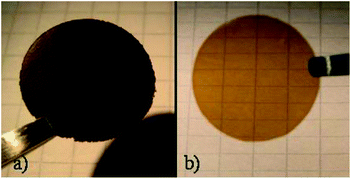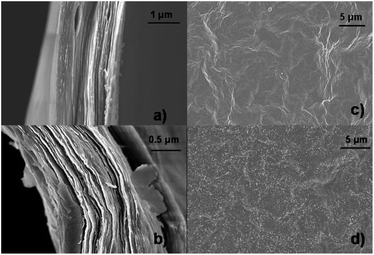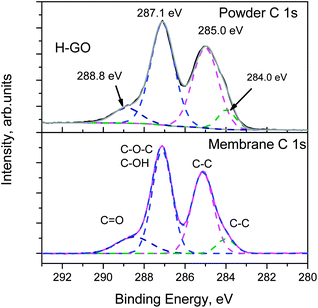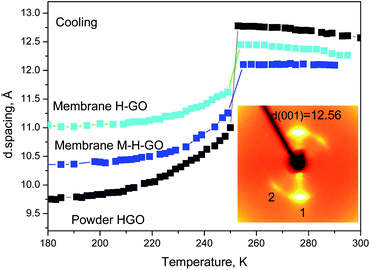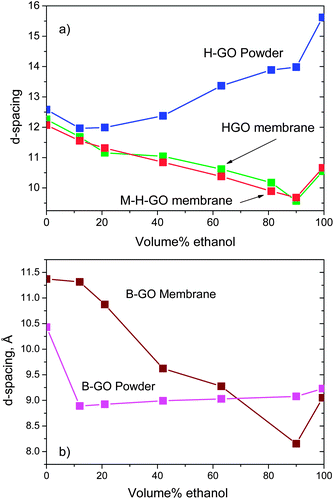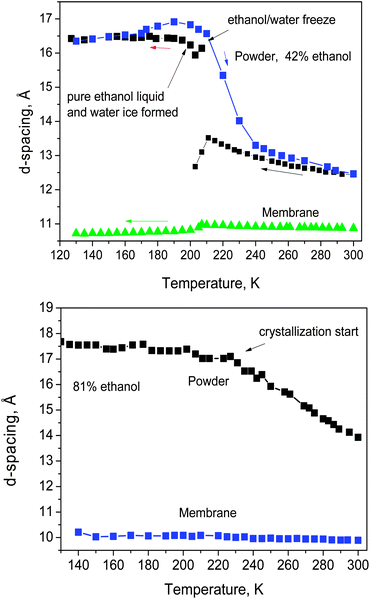The structure of graphene oxide membranes in liquid water, ethanol and water–ethanol mixtures†
Alexandr V.
Talyzin
*a,
Tomas
Hausmaninger
a,
Shujie
You
a and
Tamás
Szabó
b
aDepartment of Physics, Umeå University, Umeå, SE-901 87, Sweden. E-mail: Alexandr.talyzin@physics.umu.se
bDepartment of Physical Chemistry and Materials Science, University of Szeged, Szeged, H-6720, Hungary
First published on 14th October 2013
Abstract
The structure of graphene oxide (GO) membranes was studied in situ in liquid solvents using synchrotron radiation X-ray diffraction in a broad temperature interval. GO membranes are hydrated by water similarly to precursor graphite oxide powders but intercalation of alcohols is strongly hindered, which explains why the GO membranes are permeated by water and not by ethanol. Insertion of ethanol into the membrane structure is limited to only one monolayer in the whole studied temperature range, in contrast to precursor graphite oxide powders, which are intercalated with up to two ethanol monolayers (Brodie) and four ethanol monolayers (Hummers). As a result, GO membranes demonstrate the absence of “negative thermal expansion” and phase transitions connected to insertion/de-insertion of alcohols upon temperature variations reported earlier for graphite oxide powders. Therefore, GO membranes are a distinct type of material with unique solvation properties compared to parent graphite oxides even if they are composed of the same graphene oxide flakes.
1. Introduction
Graphite oxides are non-stoichiometric materials with a layered structure obtained by strong oxidation of graphite.1,2 Graphite oxides have attracted lots of research interest recently due to the possibility of dispersing them on single sheets in polar solvents, thus producing graphene oxide.3–5 The GO dispersion can be used for the preparation of thin films, paper-like materials or membranes composed of micrometer sized graphene oxide flakes aligned approximately parallel to each other.3,6–9 It is important to note that graphite oxides synthesized using Brodie and Hummers methods (B-GO and H-GO) are different materials not only in respect of hydration/solvation but also exfoliation properties.10,11 In fact, many different kinds of graphite oxides with strong variation of oxidation degree can be synthesized.12 Graphite oxides synthesized by different methods demonstrate also difference in types and relative numbers of functional groups attached to GO sheets.10,13 Therefore, it is not surprising that the structure of graphite oxide has been a subject of intense debates and remains to be somewhat uncertain.14–18A remarkable property of GO is easy hydration/solvation by vapours or liquids, which results in the expansion of interlayer distance. Intercalation of GO powder using liquid solvents is rather rapid and typically saturates within minutes, in contrast to intercalation by vapours which takes hours to achieve the equilibrium state.19 The multilayer structures precipitated from dispersion show an interlayer distance similar to the one in the parent GO powder (6.5–7.5 Å) and it could be expected that GO membranes will be hydrated/solvated similarly to powders.3,7,20 As we report here, this simple assumption appeared not to be true.
Unusual properties of graphite oxide membranes were reported as early as 1961 by H. P. Boehm et al. who reported that the membranes are not permeable by gases but permeable to water vapours.3 The same materials are now named mostly graphene oxide papers or membranes.6,21 The name “graphene oxide” has become common for both single layered22,23 and for multilayered materials (e.g. membranes).24 The interest in permeation properties of GO membranes was reborn recently by the study of Nair et al.,21 which reported that water vapours permeate through the membranes but not vapours of several other solvents, e.g. ethanol. The study suggested that water vapour permeation through the membranes occurs through the network of interconnected interlayers and mostly through unoxidized regions of GO flakes.21 Recent experiments showed that GO membranes also demonstrate selective ion penetration25 and can be used for filtering of some organic molecules.26 The GO membranes were also tested in fuel cells.27 Therefore, there is strong interest to study the structure of GO membranes in water and other polar solvents (e.g. alcohols).
It should be noted also that all studies of membranes mentioned above were performed on samples prepared using the Hummers graphite oxide precursor. No reports on synthesis and properties of Brodie GO membranes are available at the moment. Significant variation of the membrane properties depending on the type of precursor graphite oxide could be expected taking into account different hydration and solvation properties of precursors B-GO and H-GO in powder form.11
Surprisingly, no structural studies of solvent immersed GO membranes have been reported so far. Humidity-dependent studies of graphene oxide membranes21 and paper-like material20 structures have been reported recently, but no structural data are available for liquid solvents. Hydration and solvation properties of precursor powder graphite oxides have been reported in our earlier studies11,28–33 but it is an open question to what extent these results can be applied to the GO membranes. The most striking observation is that Hummers graphite oxide powder can be intercalated by three monolayers of water (interlayer distance d(001) = 12.4 Å at ambient temperature),12,35 2–3 monolayers of methanol or ethanol (d(001) = 15.5 Å) under ambient conditions and up to four monolayers at low temperatures (d(001) = 20.6 Å).33 Considering very large separation of layers in ethanol intercalated Hummers graphite oxide, the membranes prepared from this powder could be expected to permeate ethanol even easier than water. However, as reported, the GO membranes do not permeate ethanol at all, which is rather an intriguing property.28
The experiments presented in our study explain this apparent contradiction and reveal that GO membranes are materials with distinctly different solvation properties compared to precursor powders and cannot be intercalated by more than one alcohol monolayer even in liquid solvents. The hydration/solvation properties of GO membranes (in liquid water and ethanol) are surprisingly strongly different compared to precursor Brodie and Hummers graphite oxide powders. Hummers GO membranes demonstrate the absence of “negative thermal expansion”29 and Brodie GO membranes show the absence of phase transitions34 connected to insertion/de-insertion of alcohol upon temperature variations. The results allow us to explain unusual permeation data of GO membranes exposed to water and ethanol vapours.21
2. Experimental
Three kinds of graphene oxide membranes were prepared using the filtration method:(1) B-GO membranes were prepared from graphite oxide synthesized using the Brodie method. Details of the GO powder synthesis and characterization can be found elsewhere.12 The C/O ratio determined by XPS was 2.85.
(2) H-GO membranes were prepared using commercial graphite oxide powder purchased from ACS Materials. This graphite oxide was synthesized using the Hummers method and C/O = 2.47 was determined by XPS.
(3) The M-H-GO membrane was provided by R. Nair et al.21 It was prepared using Hummers graphite oxide synthesized following the original recipe.2 The C/O = 2.81 was determined by XPS for this sample. Our experiments showed that this sample has hydration/solvation properties very similar to the membranes prepared from commercial H-GO.
Detailed characterization of Brodie and Hummers graphite oxides used here as precursors for the preparation of B-GO and H-GO membranes is available elsewhere.11
The synthesis of the membranes includes three steps. The first step is preparation of graphene oxide dispersion by sonication of GO powder in water overnight and centrifugation to remove few-layered (or unexfoliated) particles. B-GO dispersion was prepared using addition of NaOH (0.01 mol l−1), otherwise this type of GO does not get dispersed even after prolonged sonication. The second step is deposition of GO dispersion using flow assisted self-assembly. For this purpose the GO suspension was filtered through alumina membranes (Anodisc 25, 0.2 μm, diameter: 25 mm from Whatman GmbH) using vacuum (∼10−2 bar). Finally, membranes were air dried directly on alumina filters and separated from the support. Examples of free standing GO membranes are shown in Fig. 1.
XPS spectra were recorded with a Kratos Axis Ultra electron spectrometer equipped with a delay line detector. A monochromated Al K-α source operated at 150 W, a hybrid lens system with a magnetic lens, providing an analysis area of 0.3 mm × 0.7 mm, and a charge neutralizer were used for the measurements. The binding energy scale was adjusted with respect to the C1s line of aliphatic carbon, set at 285.0 eV. All spectra were processed with the Kratos software.
The as-prepared membranes were characterized using XRD (Siemens D5000 diffractometer). It is important to note that the membranes are prepared in aqueous dispersion. Therefore, they are synthesized directly in a saturated hydration state and start to dehydrate when liquid water is removed. GO membranes need to be dried on air over a period of 1–2 days before they are separated from the alumina filter. However, the d-spacing measured for the (001) reflection within first 2–3 days after the preparation of membranes was significantly higher (∼7.5–8.6 Å for H-GO membranes) compared to d(001) found under ambient conditions for powder (7.2 Å) and continued to decrease over longer periods of time. The value of d(001) typical for precursor powder was achieved only after 3–4 weeks of on-air storage of membranes (or 1–2 hours of vacuum drying). The effect of “water trapping” which results in slow drying is consistent with the structure of membranes composed of overlaid individual GO sheets. Water from the inner part of the membranes needs to go through a labyrinth of interlayer spacings before it reaches the surface and evaporates.
A structural study of GO membranes in excess of liquid water, ethanol and water–ethanol mixtures was performed by XRD using synchrotron radiation at Max Lab, beamline I711, Sweden. X-ray diffraction images were collected from powder samples loaded in glass capillaries using the transmission geometry. The structure of GO membranes in a hydrated state was studied in situ using 0.5–1 mm pieces immersed in excess of liquid water and other solvents. Two-dimensional XRD images were recorded first from H-GO and B-GO membranes in the pristine (solvent free) state and then in the liquid immersed state with water, ethanol, methanol, water–ethanol mixtures as solvents. Liquid immersed samples were also subjected to cooling down to ∼130 K with XRD images recorded with 2–3 steps. These data are compared below with previously published results obtained on powder GO samples; the same powders were used for the preparation of the membranes.
Temperature was controlled using an Oxford Cryosystems CryoStream 700+ cooler and decreased/increased in steps of 3–10 K. The radiation wavelength was calibrated using a LaB6 standard. Fit2D software was used to integrate the diffraction images into diffraction patterns.
3. Results
3.1. Characterization of as-prepared membranes
Membranes were prepared by vacuum driven flow self-assembly of GO flakes on alumina filters using water dispersions prepared from B-GO or H-GO powder precursors (Fig. 1).The B-GO membranes appeared to be extremely flexible: they can be folded several times without breaking. The H-GO membranes are more brittle and break into pieces on attempts to fold (see Fig. 1S in ESI†). A significant difference was also revealed by the SEM study of our membrane samples with respect to the edge microstructure (Fig. 2). Both membranes (studied in the dried state) are composed of lamellae separated by free spaces. The typical thickness of these lamellae is about ∼10–20 nm which corresponds approximately to 15–30 layers of GO sheets. However, the lamellae in the B-GO membrane are densely packed and rather parallel to each other, whereas in H-GO they are non-planar in shape: corrugated in wave-like formations and separated form each other by larger free spaces. It can be suggested that H-GO flakes are in the more defect state compared to B-GO which is also consistent with weaker and broader d(001) reflections as revealed by XRD on powder samples11 and diffuse scattering recorded for membranes (see below). The free spaces between GO lamellae observed in Fig. 2 can be filled with water or other solvents upon immersion into liquid, which is important for discussion of results reported below. The planar surfaces of the B-GO and H-GO membranes are rather similar to each other showing a number of wrinkles on the micrometer size scale.
A detailed characterization of precursor graphite oxide powders has been reported in our previous studies.11 The results of XPS characterization prove that H-GO sheets were not modified significantly by sonication in water and precipitation into membranes (Fig. 3). The C/O molar ratio determined for the H-GO membrane is 2.49 compared to 2.47 for pristine powder. The M-H-GO exhibited a slightly higher C/O value of 2.81 and a small impurity of nitrogen (1.1 at%). The XPS spectra of B-GO membranes showed stronger difference compared to pristine powders, which is attributed to reaction with NaOH which had to be added to assist dispersion of GO sheets in water. The C/O ratio for pristine B-GO powder was determined by XPS as 2.85 and for the water washed membranes as 3.84 which is consistent with possible reactions of some functional groups with hydroxide ions and removal of these products by washing.
3.2. Structure of membranes in liquid water
The hydration of graphite and graphene oxide multilayers can be evaluated using the (001) reflection, which shows shifts upon changes of temperature and pressure due to insertion and de-insertion of solvents.28,32,33 The d(001) directly corresponds to the interlayer distance between individual GO flakes.A typical XRD image of membranes in the solvent free state shows two bright spots from the (001) reflection centred at d = 7.7 Å and d = 7.57 Å for H-GO and M-H-GO membranes, respectively (290 K). Swelling in liquid water resulted in an increase of interlayer distance to d = 12.29 Å and 12.09 Å for H-GO and M-H-GO respectively, Fig. 4 (additional data available also in the ESI†). Very strong diffuse scattering was observed for solvent immersed H-GO as discussed in more detail below.
The stable hydration state of membranes in liquid water was achieved within minutes, similar to powder, and did not change after at least hours of immersion. The striking feature of the XRD images recorded directly in liquid water is the very strong diffuse scattering which looks like a straight line of intensity connecting opposite (001) spots (see the inset of Fig. 4 and images in the ESI†). The diffuse scattering corresponds to disordered layers with continuous distribution of separation distances, which are significantly higher compared to the value calculated using the central position of the main spots. The shadow from a beam stopper covers the central part of the XRD image, but it is clear that the continuous distribution of interlayer distances is observed at least up to 40 Å. Strong diffuse scattering was also found for H-GO–ethanol samples. Remarkably, diffuse scattering observed for H-GO membranes in water and ethanol is significantly stronger compared to B-GO membranes (see the ESI for XRD images†). This observation is in agreement with the morphology (microstructure) of the H-GO membrane edges revealed by SEM (Fig. 2). It showed that packs of GO layers are separated by free spaces which will be filled with solvent upon soaking the membrane into liquid. Interlamellar spaces filled with solvent provide larger interlayer separations and are likely responsible for the diffuse scattering. Another possible reason could be partial delamination of the membranes in excess of solvent. However, some delamination was observed for H-GO membranes in liquid water but not in ethanol, while similar strong diffuse scattering is observed in both solvents.
The inset XRD image shown in Fig. 4 (M-H-GO–water sample) exhibits two pairs of spots from two different pieces of the membrane (marked 1 and 2). The temperature dependence of d(001) was analyzed and plotted separately for flakes 1 and 2 using integration with a rectangular mask.
The lattice expansion due to hydration in liquid water at ambient temperature (∼4.5–5 Å) is somewhat smaller for H-GO and B-GO membranes compared to powder samples. The hydrodynamic diameter of the water molecule is ∼2.7 Å.35 It is also known that insertion of a water monolayer results in lattice expansion by ∼2.2–2.5 Å36,37 for clay minerals which are also layered hydrophilic materials similar to graphite oxide. Therefore, lattice expansion of the GO membrane in liquid water corresponds to insertion of at least two water monolayers compared to the solvent free state.
Cooling the membrane–water sample results first in a slight expansion of the GO lattice (insertion of additional water) and a sharp decrease of the interlayer distance, which correlates with the point of liquid medium solidification (detected by the appearance of ice reflections). The contraction of the GO interlayer below the point of water media solidification is explained by de-insertion of the water monolayer from the GO structure. Fig. 4 shows reference data collected for H-GO powder, while for B-GO powder the reference data can be found in an earlier published study.31
The low temperature state of hydrate GO powders (∼8.7 Å for B-GO31 and ∼9.7 Å for H-GO) corresponds to hydration with one water monolayer. This water layer is attached strongly to the GO planes and is not removed when liquid water freezes. The maximal expansion of the GO lattice (∼12.7 Å for H-GO powder) due to hydration is observed just above the point of liquid water media solidification and corresponds to at least two water monolayers. The difference between low temperature and ambient temperature states corresponds to insertion/de-insertion of one water monolayer. The additional water layer has liquid-like properties and escapes from the GO structure as soon as liquid water media get frozen.31 Therefore, the existence of a liquid-like layer of water inserted between GO planes can be identified using this typical expansion/contraction of the lattice due to rapid insertion/de-insertion of water near the point of liquid media melting/solidification.
Fig. 4 shows that the down step in d(001) observed on cooling is smaller for membranes (∼1.7 Å) compared to powder. It can be explained by the loss of a water monolayer which occurs not in the whole sample but only in fraction of the interlayers. The gradual changes of d(001) upon cooling are explained by the existence of distinct hydration states stacked into a randomly packed lattice (interstratification).31
Despite some differences in the hydration degree, the type of temperature dependence observed in Fig. 4 confirms that a “liquid-like” monolayer of water is still present in the H-GO membranes similar to powder samples. Therefore, this layer could be responsible for permeation of water through the membranes. The cooling–heating cycle is reversible but re-hydration of the GO lattice shows strong hysteresis.31
The XRD images recorded from B-GO membranes immersed in water are similar to those of H-GO but with better lattice ordering, evidenced by the appearance of (002) reflections (no second order peaks were observed for H-GO powder and membranes). The difference is inherited from precursor GO powders.31,32 Better ordering of B-GO membranes is likely explained by a somewhat smaller oxidation degree and a less defect state of individual flakes. The temperature dependence of d(001) for B-GO in liquid water also exhibited a de-hydration step at the point of liquid water solidification, however the magnitude of the step was even smaller: only 1.3 Å lattice contraction was observed (from 11.4 Å at 260 K down to 10.1 Å at 220 K) while for B-GO powder the difference was 2.5 Å. Very roughly estimating, only half of the B-GO interlayers are dehydrated after solidification of bulk water media. Therefore, it can be expected that water will permeate slower through B-GO membranes.
Summarizing this section, both H-GO and B-GO membranes exhibit de-insertion of the water layer at the point of liquid water media solidification, similar to graphite oxide powders, but with a somewhat smaller degree. The fully hydrated state of GO membranes in equilibrium with the excess of liquid water includes at least two intercalated water monolayers, one of them in the liquid-like state: it is easily inserted and de-inserted if liquid water is removed or gets frozen.
3.3. Structure of the membranes in liquid alcohols
The results presented above showed general similarity for hydration of powder and the membranes in liquid water. However, the GO membranes are found to be solvated in liquid ethanol and methanol surprisingly differently compared to powders.Our previous results obtained for H-GO powder immersed in excess of liquid methanol and ethanol showed enormous swelling at low temperatures with lattice parameters over 20 Å. Insertion of at least three solvent monolayers into the GO lattice was observed at ambient temperature and four monolayers at low temperatures.29
However, results of experiments presented in Fig. 5 and 6 demonstrate that solvation of GO membranes by ethanol is strongly hindered compared to powders and does not exceed one monolayer. The interlayer distance of H-GO membranes immersed in liquid alcohols (11.12 Å for ethanol and 10.59 Å for methanol) appeared to be significantly smaller compared to powders (15.6 Å in ethanol and 13.25 Å in methanol) already at 290 K. In sharp contrast to powders, the d(001) for membranes immersed in ethanol and methanol remains almost unchanged down to 140 K and after heating back to ambient temperature (Fig. 5).
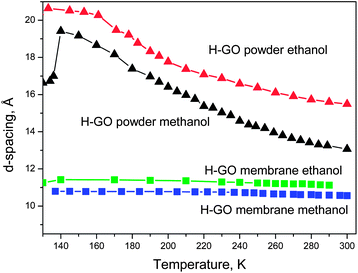 | ||
Fig. 5 Temperature dependence of d(001) of the H-GO membrane immersed in liquid ethanol  and methanol and methanol  compared to pristine H-GO powder in ethanol compared to pristine H-GO powder in ethanol  and methanol and methanol  . . | ||
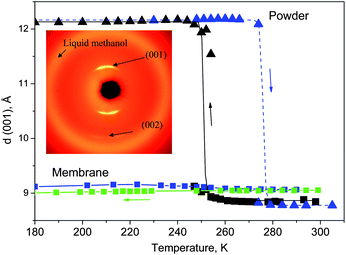 | ||
Fig. 6 Temperature dependence of d(001) of the B-GO membrane immersed in liquid ethanol  and methanol and methanol  compared to pristine H-GO powder in ethanol upon cooling compared to pristine H-GO powder in ethanol upon cooling  and heating and heating  . Powder data are from ref. 34. . Powder data are from ref. 34. | ||
Similarly strong difference was found also for B-GO membranes compared to B-GO powders. As shown in our earlier studies, the B-GO powder immersed in ethanol or methanol liquid media (one solvent monolayer state at ambient temperature d(001) = 8.9 Å (ref. 28)) exhibits a first order phase transition into an expanded phase (2-monolayer state) with a lattice expansion by ∼4 Å (ref. 34) in good agreement with the hydrodynamic size of an ethanol molecule.38
In strong contrast, the membranes showed the absence of phase transitions and almost flat temperature dependence of d(001) upon cooling in ethanol and methanol liquid media (Fig. 6).
It should be noted that the B-GO membrane immersed in ethanol showed only partial solvation at ambient temperature, which is likely explained by incomplete penetration of the solvent into the whole depth of the membrane. The XRD patterns showed two (001) reflections, one from the solvated state and the second from not solvated (see the integrated pattern in the ESI†). The temperature dependence shown in Fig. 6 is for the solvated part.
The results shown in Fig. 5 and 6 show that only one ethanol monolayer can be intercalated into B-GO and H-GO structures and no additional solvent is inserted at low temperatures and this layer is likely to be strongly attached in the GO lattice which explains the absence of ethanol vapour permeation through GO membranes reported earlier by Nair et al.21
The same result (only one ethanol layer insertion) is also confirmed by experiments with water–ethanol mixtures.
3.4. Structure of GO membranes in water–ethanol binary solutions as a function of ethanol concentration and temperature
Addition of ethanol to water results in non-trivial changes of the GO membrane structure which are, once again, rather different compared to precursor powders.Fig. 7 shows the interlayer distance measured as a function of ethanol concentration in water–ethanol mixtures at 300 K. Very similar d(001) values are observed for the H-GO membrane and powder in pure water, but adding ethanol results in opposite trends: for membranes the interlayer distance decreases and for powder it increases. The data shown in Fig. 7a allow us to explain and predict properties of H-GO membranes towards permeation of water–ethanol mixtures. Addition of ethanol to water results in contraction of the lattice and, therefore, the permeation should be slowed down in agreement with vapour permeation data by Nair et al.21
A very strong difference between the structures of powders and membranes in ethanol–water solvents was observed also for B-GO. The trend in structural modifications of B-GO membranes is similar to H-GO: addition of ethanol (up to 90%) to water results in a progressively smaller interlayer distance (Fig. 7b). Similar to previously published data for B-GO powder immersed in water–methanol,30 B-GO powder showed no change in the cell parameter for concentrations of ethanol in the range of 10–100%. The membranes did not follow this trend, exhibiting larger layer separation (compared to powders) for concentrations below 60% and smaller separations for ∼70–100%.
Therefore, it can be concluded that the membranes do not show selective intercalation by ethanol when exposed to liquid water–ethanol mixtures which could be expected looking only at powder data.30 No selective intercalation of GO membranes by methanol from water–methanol mixtures was also found (Fig. 8S in the ESI†). Both water and ethanol are inserted into the membrane structure and mutually influence the intercalation. Therefore, it is likely that both water and ethanol will permeate through the membranes when exposed to binary water–ethanol liquids.
The simultaneous intercalation of the GO lattice by water and ethanol in binary liquid mixtures can be distinguished using the temperature dependent structural study. According to earlier powder studies, intercalated water and alcohols are responsible for distinctly different structural anomalies in certain temperature intervals.29,30 However, both H-GO and B-GO membranes revealed the absence of such anomalies and almost flat temperature dependence of interlayer distance for two studied water–ethanol compositions, Fig. 8.
Slow cooling of water–ethanol liquid with 42% of ethanol results in a complex change of liquid phase composition due to fractional crystallization of liquid medium. Part of the solvent freezes upon cooling below 210 K with formation of a mixed water–ethanol solid phase. The remaining liquid is gradually enriched in ethanol and further cooling results in the formation of a pure water ice phase and pure ethanol liquid. The structure of powder immediately responds to the change of liquid phase composition, while for membranes almost a flat temperature dependence of d(001) was recorded, similar to the temperature dependence revealed in Fig. 7 for pure ethanol.
The interlayer distance observed for the H-GO membrane is much smaller compared to the powder sample at ambient temperature (d = 11.9 Å) and shows only a very small step (∼0.2 Å contraction) when fractional crystallization of liquid medium starts, indicating that a minor amount of water escaped from some of the GO membrane layers. The structure of the membrane does not expand when pure ethanol is formed at lower temperatures, that is in contrast to the powder sample which shows insertion of an additional ethanol layer below the point of ice formation. Once again, the membrane structure shows unique behaviour distinctly different compared to powders.
The temperature dependence shown in Fig. 8a can be explained only if both water and ethanol are intercalated into the GO membrane structure. The flat temperature dependence is typical for ethanol intercalation into the GO membrane structure (Fig. 5) and de-insertion of water at the point of liquid medium freezing is typical for water intercalation (Fig. 4). The difference compared to powders is that GO membranes cannot be intercalated by more than one monolayer of ethanol.
The next experiment was performed with ethanol rich solution (81% of ethanol). The interlayer distance of GO powder is higher in this liquid medium (d = 13.92 Å) at ambient temperature but is still smaller than in pure ethanol (d = 15.6 Å), reflecting intercalation with mostly ethanol and possibly smaller fraction of water. Water ice formed in these samples below 227 K and once again the GO powder immediately reacted to the change of liquid phase composition as evidenced by the change of the slope of d(001) temperature dependence. The H-GO membrane shows d(001) = 9.9 Å at ambient temperature, no steps at the point of ice formation and negligibly small variations upon cooling down to 150 K. It can be concluded that the H-GO membrane is intercalated mostly by ethanol and no liquid-like water layer is inserted into the GO structure at ambient temperature. As we know from permeation experiments, the rate of water permeation is rather slow for ethanol rich compositions. The interlayer space is blocked by a layer of ethanol intercalate and only a very minor part of interlayers is available for transport of the solvent through the membrane.
In summary of this section: the interlayer distance of H-GO powder reacts rapidly to variations of water–ethanol concentration in the process of cooling which is explained by insertion and de-insertion of water and ethanol. The H-GO membranes demonstrated sharply distinct properties: only one monolayer of ethanol was intercalated into the GO structure at any conditions. The water monolayer can be intercalated over the ethanol monolayer in water rich solutions, but at high ethanol concentrations the ethanol entirely blocks the entrance into the GO interlayer. Once again the sharp difference between properties of GO powder and membranes demonstrates that GO membranes are materials with unique properties which cannot be predicted knowing hydration/solvation of powders. The difference needs to be assigned to specific geometry of the interlayer entrance formed by edge functional groups and groups attached to GO planes as discussed below.
4. Discussion
The strong difference in intercalation of the GO membranes with alcohols compared to parent powders is surprising considering that both materials are composed of the same GO flakes and exhibit the same lattice spacing in the solvent-free state. It is not possible to rule out that some modification of GO flakes occurs in the process of membrane preparation (sonication treatment and deposition) but characterization of membranes by XPS shows only rather minor changes in the chemical composition of GO flakes compared to powders.Comparing powder and membrane structures one can suggest that the number of ethanol layers intercalated into the interlayer space of the GO structure is controlled by the geometry of GO sheet edges. The membranes exhibit geometry with edge groups located over the functional groups of neighbouring GO planes. In contrast, the powder has mostly edge over edge configuration of functional groups (Fig. 9). Different kinds of functional groups are attached to the GO planes and edges, thus providing a difference. It is known that –OH groups are partly deprotonated when GO is immersed in water, which results in negative charges created on planes and, most of all, on the GO flake edges. For example, it is known that charged edges of GO flakes repel each other in water.39 Therefore, the repulsion of deprotonated edges will be stronger in the geometry typical for powder samples. Moreover, the process of the membrane self-assembling can be affected by repulsion of charged edges so that the final geometry of overlaid flakes avoids edge over edge configurations. It can be suggested that easier intercalation of water and alcohols into the GO powder structure is assisted by repulsion of negatively charged edges.
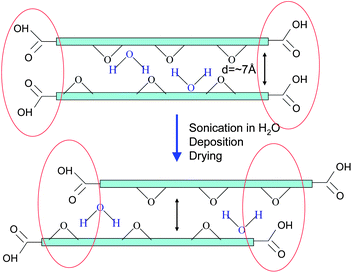 | ||
| Fig. 9 Schematic image of the arrangement of graphene oxide flakes in powder and membrane, the interlayer entrances are controlled by different combinations of functional groups. | ||
Both B-GO and H-GO membranes are not intercalated by ethanol and methanol above the one-monolayer state at ambient temperature and even after cooling. That is in strong contrast to GO powders which can easily be intercalated by two (Brodie) and up to four (Hummers) ethanol monolayers and rapidly respond to change of liquid medium composition. However, hydration of B-GO and H-GO membranes shows similarity to powders. The liquid-like mobile water layer exists not only in powders31 but also in GO membranes as it is evidenced by rapid withdrawal of this water layer and contraction of the lattice upon cooling the GO–H2O sample at the moment of liquid water medium freezing. Neutron scattering data published earlier also demonstrated that first layers of water inserted into the GO structure are attached more rigidly to the certain sites but when the interlayer distance is increased over ∼9–10 Å the next water layer exhibits translational motion along the interlayer space.19,20,40 A more detailed schematic summary of structural changes which occur with GO upon hydration is provided in the ESI, Fig. 9s.†
The results presented here allow us to predict some permeation properties of GO membranes towards water and ethanol. Permeation of water is expected to be easy due to the existence of a liquid-like layer but adding ethanol should result in slower permeation. It can also be expected that the more crystalline B-GO membranes will permeate water slower compared to the more defected and poorly ordered H-GO membranes. It should be noted that structural experiments described here were performed with liquid solvents and cannot be directly applied to published permeation data for vapours21 while no data for permeation of liquids are available at the moment.
We also believe that permeation through membranes is not limited to unoxidized regions of GO flakes. The existence of “graphene capillaries” suggested in ref. 21 and 41 is not in agreement with most of the recently published HRTEM studies which show that these regions do not form interconnected networks.42,43 Only about 16% of graphene oxide area in non-oxidized regions was reported by Erickson et al. for individual GO flakes.43 Note that these areas need to overlap on two sides of inter-layers to form “graphene capillaries” and such areas will occupy significantly smaller regions, insufficient to form interconnected networks.
If the relatively broad interconnected graphene regions existed, the individual graphene oxide flakes would have to be also electrically conductive. In contrast, it is well known that strongly oxidized graphene oxide sheets (C/O close to 2–3 as in studied samples) demonstrate insulating properties due to the absence of interconnected sp2-regions and become conductive only after at least partial reduction, simultaneously with the appearance of connected graphene regions.44,45
Double layered ice suggested as the explanation of fast water permeation in ref. 41 is also unlikely to exist in hydrated graphite oxide: any ordered structure of water would result in additional reflections in XRD patterns and certain features in infrared spectra.44 In contrast, no specific IR lines which could be assigned to double layer ice have so far been reported for hydrated GO while it is well known that water is intercalated into the GO structure in a completely disordered state.28,32,40 No additional reflections due to water intercalation were found also in the XRD study presented here.
The liquid-like state of the water monolayer which corresponds to the GO state with interlayer distance over 9 Å (ref. 19, 31 and 40) (preserved in membranes) and the hydrophilic nature of GO flakes are the key factors which need to be taken into account in modelling of GO membrane permeation. Permeation is expected to proceed by flow through the whole interlayer space including oxidized areas which occupy major part of the graphene oxide surface. Therefore, modelling of water layer permeation between two hydrophilic plates would be a better approximation to the structure of hydrated GO.
One needs to note that vapour permeation and pervaporation rates, reported to be identical for GO membranes by Nair et al.,21 are not extraordinary and not higher compared to other known types of hydrophilic membranes used for industrial separation of water from ethanol over last two decades. Recent reviews of membrane pervaporation and vapour permeation are given by P. Shao and R.Y.M. Huang38 and B. Bolto et al.35 The extraordinary water flow rate estimated by Nair et al.21 is not an experimental result but interpretation. The model included certain unlikely speculation: the GO flakes were assumed to be as perfect as ideal graphene sheets and not permeable through planes (not perforated). The water was speculated to run a 2 μm path in each interlayer between individual GO sheets which resulted in the model in a 1000 times longer water path compared to the thickness of membranes (no holes in the 2 μm size flakes). However, it is known that GO flakes (especially after extensive sonication in water as in the process of membrane preparation) are rather defected and typically exhibit a large number of holes with diameters over 1 nm and up to micrometer size.42,43,45,46 Considering only 2% of GO flake surface is covered by holes, as in the study by K. Erickson et al.,43 and typical distance between them of about 50–100 nm, the penetration path of water through the membrane (and flow rate estimation accordingly) will be decreased by at least two orders of magnitude compared to calculations of Nair et al.21 Therefore, a special mechanism which requires explanation of super-fast water flow is likely not required to explain permeation through GO membranes.
Evaluation of true flow rates of water through the GO membranes is complicated also by the obvious presence of free spaces between lamellae, as shown in Fig. 2. It is obvious that the macroscopic thickness of membrane includes contributions from both densely packed GO layers and free spaces between lamellae. Thus the total number of penetrated interlayers can be significantly smaller while flow of water through free spaces will contribute to total permeation rates significantly.
The structural experiments described above were performed for membranes completely immersed into liquid solvents, while in the setup by Nair et al.21 permeation of solvent vapours was evaluated. The hydration/solvation of GO with vapour is known to be slower and not as complete as in the case of liquids.19,21 Therefore, it can be expected that permeation of GO membranes by liquids and by vapours could be different. On the other hand, as reported by Nair et al.,21 turning the vapour permeation setup upside down, thus making contact of liquid with the membrane surface (pervaporation), did not change permeation rates through GO membranes, see supplementary information of ref. 21. However, even in the pervaporation setup the membrane is not covered by the liquid phase from both sides as in our structural study and applying our results to published permeation data needs to be done with certain caution.
In contrast, the complete immersion of the membranes in liquids is typical for e.g. ion permeation experiments published recently.25 Therefore, our data are of fundamental value for ion permeation experiments (of course, adding ions will also change the solvation properties). The liquid-hydrated structure also corresponds to the state of GO membranes in the process of their preparation using water dispersion. Therefore, the structural results reported here are also important for understanding and tuning the process of the membrane deposition. Chemical functionalization of membranes is also often performed in liquid solutions26 and occurs in the hydrated state. Hydrated membranes and papers have also been proposed for a number of applications, e.g. for supercapacitors, which includes hydration of GO membranes to make it insulating.47
In summary, GO membranes in liquid solvents are hydrated and solvated strongly differently compared to precursor GO powders. The GO membranes are solvated by a maximum of only one ethanol (or methanol) layer and the composition remains unchanged upon cooling to ∼140 K. That is in sharp contrast with powders as it is known that the B-GO powder exhibits phase transitions into a two-monolayer solvate at low temperature in both ethanol and methanol, whereas H-GO shows “pseudo-negative thermal expansion” with up to four inserted alcohol monolayers at low temperatures. Both B-GO and H-GO membranes are hydrated in liquid water similarly to powders with the formation of a liquid-like monolayer which is rapidly inserted and de-inserted into the GO structure. This layer is suggested to be responsible for fast water permeation through GO membranes. Addition of ethanol to water results in a progressively smaller d(001) spacing of the membrane lattice whereas for powders the trend is opposite which explains why membranes are not permeated by ethanol. It can be concluded that GO membranes show rapid exchange of water between the lattice and liquid media, whereas ethanol blocks the entrance to interlayers. The structural study of GO membranes in water, alcohols and water–alcohol mixtures is important for understanding of membrane deposition, permeation and any solution-involved applications and processes.
Acknowledgements
We would like to thank Dr R. Nair and Prof. I. Grigorieva for providing samples of the graphene oxide membrane and shared knowledge about methods of the membrane preparation. We thank Dr Diana Thomas for the help with low-temperature XRD experiments performed at MAX-lab, beamline I711, Lund, Dr A. Schinkarev for help with XPS and Dr Per Hörstedt for help with SEM. This work was financially supported by the Swedish Research Council, Grant no. 621-2012-3654, and by Ångpanneföreningens Forskningsstiftelse.References
- B. C. Brodie, Ann. Chim. Phys., 1860, 59, 466 Search PubMed.
- W. S. Hummers and R. E. Offeman, J. Am. Chem. Soc., 1958, 80, 1339 CrossRef CAS.
- H. P. Boehm, A. Clauss and U. Hofmann, J. Chim. Phys. Phys.-Chim. Biol., 1961, 58, 141–147 CAS.
- T. Szabo, V. Hornok, R. A. Schoonheydt and I. Dekany, Carbon, 2010, 48, 1676–1680 CrossRef CAS PubMed.
- Y. W. Zhu, W. W. Cai, R. D. Piner, A. Velamakanni and R. S. Ruoff, Appl. Phys. Lett., 2009, 95, 103104 CrossRef.
- D. A. Dikin, S. Stankovich, E. J. Zimney, R. D. Piner, G. H. B. Dommett, G. Evmenenko, S. T. Nguyen and R. S. Ruoff, Nature, 2007, 448, 457–460 CrossRef CAS PubMed.
- X. Wen, C. W. Garland, T. Hwa, M. Kardar, E. Kokufuta, Y. Li, M. Orkisz and T. Tanaka, Nature, 1992, 355, 426–428 CrossRef CAS.
- N. A. Kotov, I. Dekany and J. H. Fendler, Adv. Mater., 1996, 8, 637–641 CrossRef CAS.
- N. I. Kovtyukhova, P. J. Ollivier, B. R. Martin, T. E. Mallouk, S. A. Chizhik, E. V. Buzaneva and A. D. Gorchinskiy, Chem. Mater., 1999, 11, 771–778 CrossRef CAS.
- H. P. Boehm and W. Scholz, Z. Anorg. Allg. Chem., 1965, 335, 74–79 CrossRef CAS.
- S. J. You, S. M. Luzan, T. Szabo and A. V. Talyzin, Carbon, 2013, 52, 171–180 CrossRef CAS PubMed.
- T. Szabo, O. Berkesi, P. Forgo, K. Josepovits, Y. Sanakis, D. Petridis and I. Dekany, Chem. Mater., 2006, 18, 2740–2749 CrossRef CAS.
- C. Botas, P. Alvarez, C. Blanco, R. Santamaria, M. Granda, P. Ares, F. Rodriguez-Reinoso and R. Menendez, Carbon, 2012, 50, 275–282 CrossRef CAS PubMed.
- L. B. Casablanca, M. A. Shaibat, W. W. W. Cai, S. Park, R. Piner, R. S. Ruoff and Y. Ishii, J. Am. Chem. Soc., 2010, 132, 5672–5676 CrossRef PubMed.
- A. Lerf, H. Y. He, M. Forster and J. Klinowski, J. Phys. Chem. B, 1998, 102, 4477–4482 CrossRef CAS.
- D. W. Lee, L. De Los Santos, J. W. Seo, L. L. Felix, A. Bustamante, J. M. Cole and C. H. W. Barnes, J. Phys. Chem. B, 2010, 114, 5723–5728 CrossRef CAS PubMed.
- W. Gao, L. B. Alemany, L. J. Ci and P. M. Ajayan, Nat. Chem., 2009, 1, 403–408 CrossRef CAS PubMed.
- W. W. Cai, R. D. Piner, F. J. Stadermann, S. Park, M. A. Shaibat, Y. Ishii, D. X. Yang, A. Velamakanni, S. J. An, M. Stoller, J. H. An, D. M. Chen and R. S. Ruoff, Science, 2008, 321, 1815–1817 CrossRef CAS PubMed.
- A. Buchsteiner, A. Lerf and J. Pieper, J. Phys. Chem. B, 2006, 110, 22328–22338 CrossRef CAS PubMed.
- J. Zhu, C. M. Andres, J. D. Xu, A. Ramamoorthy, T. Tsotsis and N. A. Kotov, ACS Nano, 2012, 6, 8357–8365 CrossRef CAS PubMed.
- R. R. Nair, H. A. Wu, P. N. Jayaram, I. V. Grigorieva and A. K. Geim, Science, 2012, 335, 442–444 CrossRef CAS PubMed.
- A. Kolmakov, D. A. Dikin, L. J. Cote, J. X. Huang, M. K. Abyaneh, M. Amati, L. Gregoratti, S. Gunther and M. Kiskinova, Nat. Nanotechnol., 2011, 6, 651–657 CrossRef CAS PubMed.
- M. Krueger, S. Berg, D. Stone, E. Strelcov, D. A. Dikin, J. Kim, L. J. Cote, J. X. Huang and A. Kolmakov, ACS Nano, 2011, 5, 10047–10054 CrossRef CAS PubMed.
- C. Cheng and D. Li, Adv. Mater., 2013, 25, 13–30 CrossRef CAS PubMed.
- P. Z. Sun, M. Zhu, K. L. Wang, M. L. Zhong, J. Q. Wei, D. H. Wu, Z. P. Xu and H. W. Zhu, ACS Nano, 2013, 7, 428–437 CrossRef CAS PubMed.
- J. M. Zhu, L. W. Zhu, Z. F. Lu, L. Gu, S. L. Cao and X. B. Cao, J. Phys. Chem. C, 2012, 116, 23075–23082 CAS.
- K. Feng, B. B. Tang and P. Y. Wu, ACS Appl. Mater. Interfaces, 2013, 5, 1481–1488 CAS.
- A. V. Talyzin, B. Sundqvist, T. Szabo, I. Dekany and V. Dmitriev, J. Am. Chem. Soc., 2009, 131, 18445–18449 CrossRef CAS PubMed.
- S. J. You, B. Sundqvist and A. V. Talyzin, ACS Nano, 2013, 7, 1395–1399 CrossRef CAS PubMed.
- S. J. You, J. C. Yu, B. Sundqvist, L. A. Belyaeva, N. V. Avramenko, M. V. Korobov and A. V. Talyzin, J. Phys. Chem. C, 2013, 117, 1963–1968 CAS.
- A. V. Talyzin, S. M. Luzan, T. Szabo, D. Chernyshev and V. Dmitriev, Carbon, 2011, 49, 1894–1899 CrossRef CAS PubMed.
- A. V. Talyzin, V. L. Solozhenko, O. O. Kurakevych, T. Szabo, I. Dekany, A. Kurnosov and V. Dmitriev, Angew. Chem., Int. Ed., 2008, 47, 8268–8271 CrossRef CAS PubMed.
- A. V. Talyzin, B. Sundqvist, T. Szabo and V. Dmitriev, J. Phys. Chem. Lett., 2011, 2, 309–313 CrossRef CAS.
- S. J. You, S. Luzan, J. C. Yu, B. Sundqvist and A. V. Talyzin, J. Phys. Chem. Lett., 2012, 3, 812–817 CrossRef CAS.
- B. Bolto, M. Hoang and Z. L. Xie, Water Res., 2012, 46, 259–266 CrossRef CAS PubMed.
- M. W. Moller, U. A. Handge, D. A. Kunz, T. Lunkenbein, V. Altstadt and J. Breu, ACS Nano, 2010, 4, 717–724 CrossRef PubMed.
- K. Devineau, I. Bihannic, L. Michot, F. Villieras, F. Masrouri, O. Cuisinier, G. Fragneto and N. Michau, Appl. Clay Sci., 2006, 31, 76–84 CrossRef CAS PubMed.
- P. Shao and R. Y. M. Huang, J. Membr. Sci., 2007, 287, 162–179 CrossRef CAS PubMed.
- L. J. Cote, F. Kim and J. X. Huang, J. Am. Chem. Soc., 2009, 131, 1043–1049 CrossRef CAS PubMed.
- A. Lerf, A. Buchsteiner, J. Pieper, S. Schottl, I. Dekany, T. Szabo and H. P. Boehm, J. Phys. Chem. Solids, 2006, 67, 1106–1110 CrossRef CAS PubMed.
- D. W. Boukhvalov, M. I. Katsnelson and Y. W. Son, Nano Lett., 2013, 13, 3930–3935 CrossRef CAS PubMed.
- D. Pacile, J. C. Meyer, A. F. Rodriguez, M. Papagno, C. Gomez-Navarro, R. S. Sundaram, M. Burghard, K. Kern, C. Carbone and U. Kaiser, Carbon, 2011, 49, 966–972 CrossRef CAS PubMed.
- K. Erickson, R. Erni, Z. Lee, N. Alem, W. Gannett and A. Zettl, Adv. Mater., 2010, 22, 4467–4472 CrossRef CAS PubMed.
- G. A. Kimmel, J. Matthiesen, M. Baer, C. J. Mundy, N. G. Petrik, R. S. Smith, Z. Dohnalek and B. D. Kay, J. Am. Chem. Soc., 2009, 131, 12838–12844 CrossRef CAS PubMed.
- Y. Si and E. T. Samulski, Nano Lett., 2008, 8, 1679–1682 CrossRef CAS PubMed.
- K. P. Loh, Q. L. Bao, G. Eda and M. Chhowalla, Nat. Chem., 2010, 2, 1015–1024 CrossRef CAS PubMed.
- W. Gao, N. Singh, L. Song, Z. Liu, A. L. M. Reddy, L. J. Ci, R. Vajtai, Q. Zhang, B. Q. Wei and P. M. Ajayan, Nat. Nanotechnol., 2011, 6, 496–500 CrossRef CAS PubMed.
Footnote |
| † Electronic supplementary information (ESI) available. See DOI: 10.1039/c3nr04631a |
| This journal is © The Royal Society of Chemistry 2014 |

